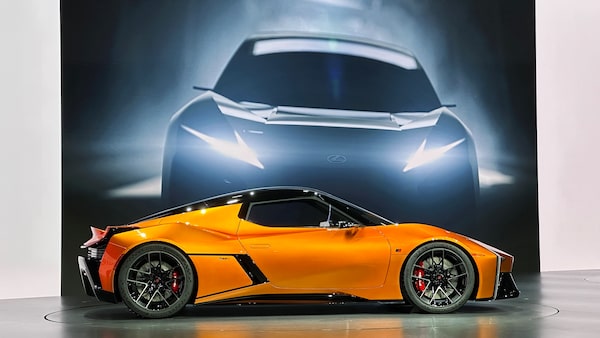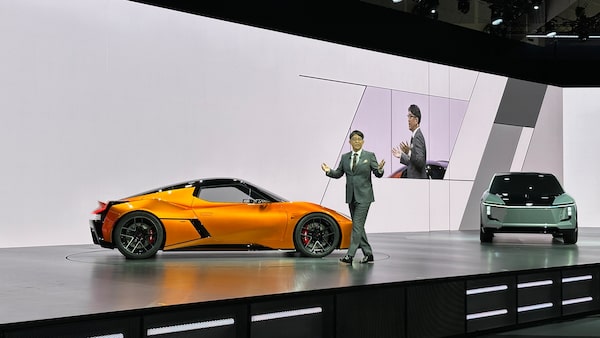
The Toyota FT-Se after it was revealed at the 2023 Japan Mobility Show.Mark Richardson/The Globe and Mail
Toyota used its stage here at the Japan Mobility Show to introduce some all-electric concepts that, a few years ago, would have been thought a pipe dream. After all, the maker didn’t believe all-electric vehicles were the best choice for the future and it’s still skeptical. These days though, it seems likely they’ll make production soon.
The Toyota FT-Se is a battery-powered sportscar and the FT-3e is a battery-powered crossover, both built on the same next-generation platform that is, apparently, flexible enough to be used in many iterations. There were no details given of their powertrains or capacities, but that’s not the point – they use smaller and denser “prismatic” lithium-ion batteries that mean they are, quite literally, the shape of things to come.
“The question is, how can we minimize the size of each component (of a vehicle) as much as possible?” said Hiroki Nakajima, chief technology officer of Toyota Motor Corp. “Thanks to the downsizing of technology, we can realize new shapes, maybe that you’ve never seen.”

The smaller and denser 'prismatic' lithium-ion batteries developed by Toyota on display at the 2023 Japan Mobility Show.Mark Richardson/The Globe and Mail
The principle is simple: when designers are less constrained by large components that must be included in a vehicle, such as engines, driveshafts and now batteries, then there’s more space for more possibilities and their imaginations can run wild.
The prismatic batteries are about 70 per cent of the size of current batteries and can be squeezed together more compactly, and they are just the beginning: Toyota expects to introduce solid-state batteries by 2028, which would be even smaller and more energy-dense. Engineers would have the choice of equipping a vehicle for either more power or more range, or both.

The interior of the Toyota FT-Se after it was revealed at the 2023 Japan Mobility Show.Mark Richardson/The Globe and Mail
Lexus – Toyota’s premium brand – also introduced a pair of electric vehicles that use similar batteries. The LF-ZL is an aspirational sedan that will likely stay a concept, but was created to show what’s possible when cars have more space available for the passengers. The LF-ZC, however, is intended to herald an SUV that will see production in 2026. Lexus expects to be an all-electric brand by 2035, while Toyota expects to still produce hybrids and plug-in hybrids, and hydrogen-powered commercial vehicles.

The Lexus LF-ZC after it was revealed at the 2023 Japan Mobility Show.Mark Richardson/The Globe and Mail

The spacious interior of the Lexus LF-ZL.Mark Richardson/The Globe and Mail
(All these lettered names have meanings: FT stands for “Future Toyota,” while Se stands for “Sports electric” and 3e is “third-generation electric.” LF stands for “Lexus Future,” with ZL being “Zero-emission Luxury” and ZC being “Zero-emission Catalyst.” The letters aren’t evocative, but they’re better than the full names.)
The Toyota sportscar concept looks similar to the old Toyota MR2, but its future is less certain: it may have been at the show to add some spice to a lineup that included boxy electric delivery trucks and service vehicles intended for the Asian market. There was some GR branding on the FT-Se and it’s clearly something the performance side of Toyota will want to pursue as an all-electric halo car. It may even get to benefit from the “manual transmission” that Toyota’s been working on, that simulates a stick-shift gearbox in a battery-powered car.
Part of the appeal of both Toyotas, and the two Lexuses as well, will be the use of the company’s new proprietary “Arene” software, which will make the vehicles more customizable and more personal than ever before. Down the road, the Arene system should be able to let you program your car to drive exactly as you want it to: it might copy the handling of an old Celica, for example, or perhaps the Honda S2000 you aspired to as a youth. You might set it to replicate the dynamics of a virtual car you race in a video game. It will make the real vehicle more acutely aware of your preferences, and perhaps the more expensive Lexus will be even more sensitive to your every whim.

The Toyota FT-3e after it was revealed at the 2023 Japan Mobility Show.Mark Richardson/The Globe and Mail
“When we get to the point where the operating system is literally built in tandem with the hardware, then it opens up certain opportunities,” said Simon Humphries, chief branding officer for Toyota Motor Corp. “The most obvious is that you’ll be able to program the drive dynamics. But if the car is a sensor, and it can see and it can hear and whatever else, we can use that to create content. For example, we have a finger-pointing application, so literally, you can drive the car (and point at someone) and say, ‘he looks cool – where’d he buy that shirt?’ Or ‘that’s a restaurant – book me a table.’”
Toyota still believes that purely electric cars have limited overall benefits for the environment, and that the planet’s raw materials and limited resources might often be put to better use in hybrid and plug-in hybrid vehicles for people who don’t need cars with huge and costly batteries. However, government regulations around the world are mandating the move to battery-powered electric vehicles, and so Toyota and Lexus are now working to make EVs that are satisfying to drive. The concepts on stage here in Tokyo are evidence of that.
“The role of cars will be to connect to society and expand the possibilities,” said Koji Sato, president of Toyota Motor Corp. when he introduced the FT-Se and FT-3e on stage here in Tokyo. “What you want will create a car that’s just for you. That is the future with next-generation battery EVs and software-defined vehicles.”
The writer was a guest of the automaker. Content was not subject to approval.

Toyota Motor Corp. president Koji Sato on stage with the newly revealed Toyota FT-Se and FT-3e during the 2023 Japan Mobility Show.Mark Richardson/The Globe and Mail
 Mark Richardson
Mark Richardson